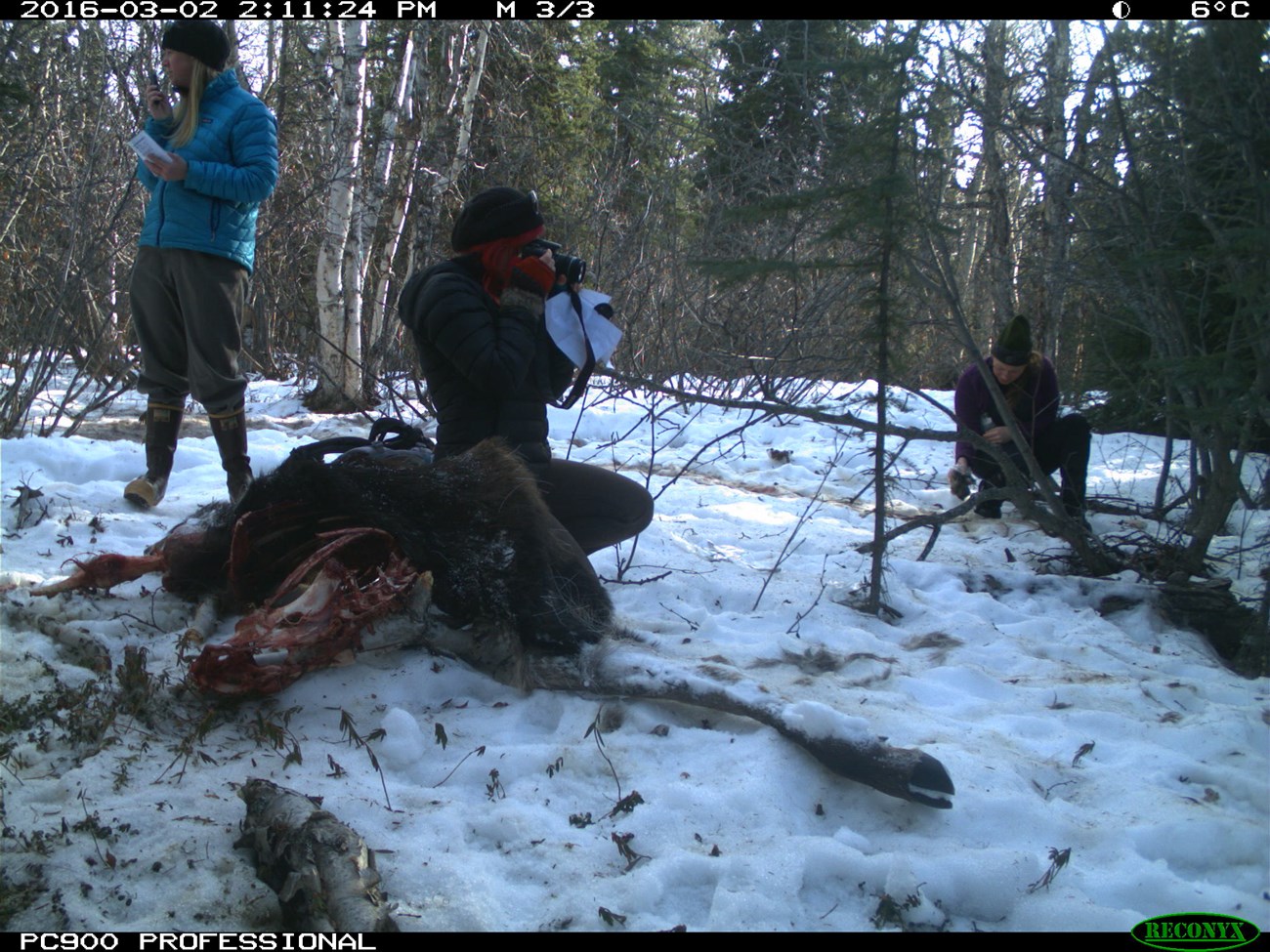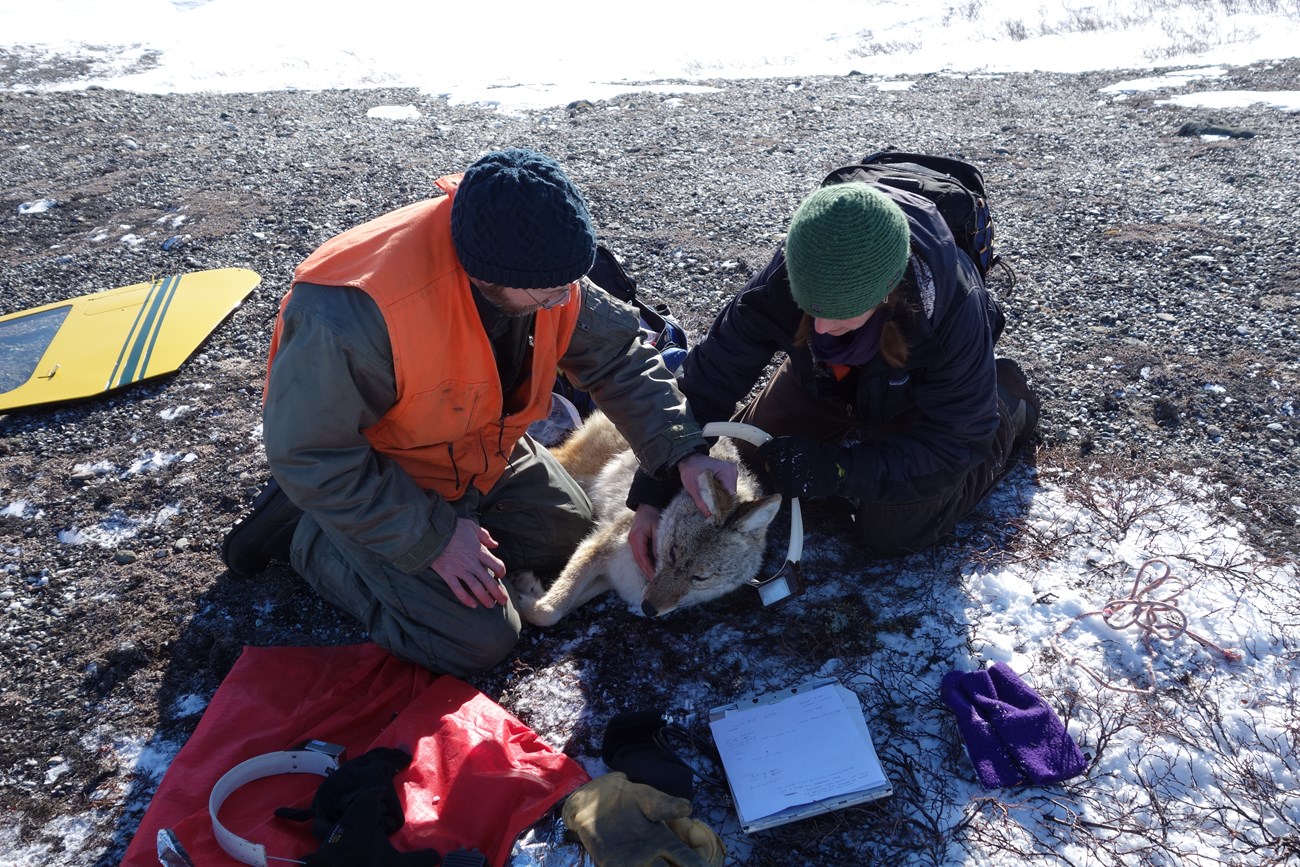Last updated: July 16, 2019
Article
Scavenging and Landscape Use of Mesocarnivores in Denali

NPS Photo
Mesocarnivore release is defined as the expansion in range and/or abundance of a smaller predator following the reduction or removal of a larger predator. These effects can extend beyond the small carnivores to include their prey. These “ripple effects” throughout an ecosystem are known as trophic cascades. But determining if, how, and when these cascades occur is very complex.
In the summer of 2012, Dr. Laura Prugh of the University of Washington (then at University of Alaska Fairbanks), started a study on interactions between carnivore species in Denali and surrounding areas. One goal of the study was to determine which are the most important factors controlling mesocarnivore populations in the park, particularly those of coyotes. Is it suppression by wolves? Availability of prey? Habitat characteristics like snow? This information can be used to determine the strength of mesocarnivore release and resulting effects on the mesocarnivore community.
In the first part of the study, researchers Kelly Sivy and Casey Pozzanghera found that scavenging seemed to be a key pathway of interaction between wolves and smaller carnivores – and that the lure of scavenging might be a “fatal attraction” between wolves and smaller carnivores; driving smaller carnivores to maintain a proximity to wolves in order to scavenge, but ultimately leading to their demise and reductions in their populations.
In part two of project, researcher Kaija Klauder analyzed two types of data to tackle two different angles on the relationships between wolves and smaller carnivores. In the first, photo data from carcass sites allowed a better understanding of how different carnivores use this valuable but risky winter resource. Next, collar data from GPS collared coyotes who shared a landscape with GPS collared wolves was used to see how coyotes behaved in response to wolves.
Scavenging
Some papers have posited that by creating carcass sites at which to scavenge, top carnivores “provision” smaller carnivores with additional food resources. But given the tendency of larger carnivores to kill smaller ones when given the chance, and the fact that animals die of natural causes and thus carcasses are available even without the help of large carnivores, is this “free lunch” scenario accurate in Denali?To find out, researchers put up motion-sensitive cameras at wintertime carcass sites, which took photos of all the animals that visited (see Denali's wolf ID project for what else these photo data can be used for). From the photos, researchers saw not only what species visited, but also how many times, for how long, and at what time of day. They could also compare their behavior—specifically, how vigilant (looking around for danger) the species were. The study focused on wolves, wolverines, coyotes, and red foxes, because those were the species that scavenged. There was no evidence of marten or lynx scavenging, and bears are not active during the winter (though they are more than happy to scavenge a carcass in the summer).
Based on the findings in part one of this study, and on other studies elsewhere, researchers expected to see lots of scavenging activity by all the mesocarnivores, as well as by wolves. Instead, they found that wolves and wolverines do the most scavenging, and that red foxes and especially coyotes do relatively little. Wolverines were the least vigilant (perhaps not surprising given their fearless natures), and other species were similar to one another. There was no evidence that animals were active at different times of day or tried to avoid times when larger species were active. All the species spent more time scavenging at carcasses that were not wolf kills – likely because these represented a lot of food compared to the leftovers after a pack is done with a fresh kill.
While it wasn’t a big surprise that wolverines scavenge extensively, wolves did more scavenging than expected—they were the most photographed animal at the carcass sites. Foxes and coyotes scavenged a lot less than in other studies, and they avoided carcasses in areas where wolves were often located. In fact, it’s a bit of a mystery that in part one of this study, coyote scat had lots of ungulate hair in it, but in part two only minimal coyote scavenging was documented. One explanation could be that if scavenging is very risky for coyotes, they might only scavenge on very fresh carcasses where they could quickly get a lot of food and then leave. Because it took at least several days to identify and then access a carcass and put up a camera, researchers may have missed the window when coyotes do most of their scavenging.
This research indicates that in Denali, carrion (dead animals) is a resource that all the carnivores are competing for—and that the biggest and toughest ones are winning. This means that wolves aren’t benefitting the smaller species by creating more carrion—instead, wolves are eating it themselves! It also makes it clear that carrion isn’t simply a “free lunch” for scavengers, it’s a food source that is risky— maybe even too risky for smaller species like coyote and foxes.

NPS Photo
Coyotes and Wolves
Given the complicated relationship between wolves and coyotes, how exactly do coyotes respond to living in an area full of wolves? GPS collar technology offers an opportunity to get some answers.From 2013-2016, nine coyotes were darted and fitted with GPS collars. These collars allowed researchers to gather some basic information on the coyotes, such as their home range size and survival, as well as see how coyotes selected habitat in the park and how they respond to wolves. Coyotes certainly have reason to avoid wolves, which have a habit of killing coyotes. But coyotes might also benefit from being near wolves, by being able to scavenge, or just to make sure they don’t get surprised. Consequently, the study examined how coyotes responded to wolves being nearby, and also how coyotes responded to areas that wolves use frequently (even if no wolves happen to be present).
Researchers found that coyotes maintain very large home ranges in Denali – an average of 291km2, the largest on record! They also have low survival rates, and the biggest source of mortality was being killed by larger carnivores like wolves and bears. Not surprisingly then, results showed that coyotes always avoided being near to wolves. Coyotes also avoided areas of high wolf use in the summer. However, coyotes switched to preferring areas of high wolf use in the winter. There was also some evidence that coyotes were less concerned about the danger of wolves when coyotes were in open areas instead of in thick vegetation.
There are two potential explanations for the fact of coyotes using the same areas as wolves in the winter. The first is that they might be doing so in order to scavenge. However given the contrasting evidence on scavenging, it’s not clear that this is sufficient explanation. Another reason might be that in the winter, animals need to be very careful about saving energy. They tend to use the easiest travel routes through the snow – and what’s easiest for a coyote is also what’s easiest for a wolf, meaning they might end up using the same areas in the wintertime out of necessity. Overall the data showed that Denali is a very tough place to be a coyote, with limited food and a lot of competitors.
